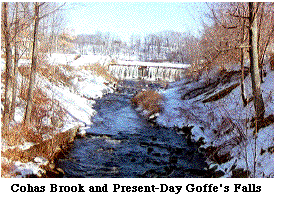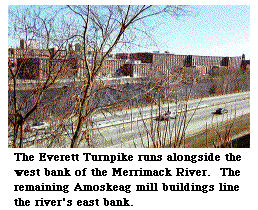A number of archeological "digs" have produced evidence that several American Indian tribes lived in what is now Manchester long before frontiersmen entered the region. The Indian villages were located primarily near the Amoskeag Falls region of the Merrimack River, and near Cohas Brook. The brook, which has its source in Lake Massabesic, approximately 4 miles east of the Merrimack, runs westward near the Manchester-Londonderry border, and empties into the river. Both bodies of water provided excellent fishing grounds for the Indians and extensive hunting grounds were nearby.
Credit for the first formal "settlement" of Manchester is given to John Goffe, who acquired land on the north bank of Cohas Brook, near the point where it joins the Merrimack, as early as 1722. Several years later, Goffe, his wife, and his two brothers-in-law and their wives, left Londonderry and built homes on this land. Goffe constructed a dam across the brook, and proceeded to build and operate a sawmill.
 In the
photograph shown here, taken in the section of present-day Manchester
known as Goffe's Falls, a 20th century dam across Cohas Brook is
visible, as well as the waterfall it creates. Pine Island Pond is
located directly behind the dam. Numerous homes have been built along
the shores of the pond, which is used for many recreational purposes.
Cohas Brook enters the Merrimack about 200 yards from where the
photograph was taken.
In the
photograph shown here, taken in the section of present-day Manchester
known as Goffe's Falls, a 20th century dam across Cohas Brook is
visible, as well as the waterfall it creates. Pine Island Pond is
located directly behind the dam. Numerous homes have been built along
the shores of the pond, which is used for many recreational purposes.
Cohas Brook enters the Merrimack about 200 yards from where the
photograph was taken.
Manchester was not incorporated as a
city until 1846. Its history during the rest of the 19th century, and
up to the middle of the 20th century, was defined primarily by the
successes and failures of the Amoskeag Manufacturing Company, owner
of one of the largest set of mill buildings in the world, and by the
customs of immigrant mill workers.  The
Merrimack River, which divides the city into East and West "sides",
served as a source of power for the great mills.
The
Merrimack River, which divides the city into East and West "sides",
served as a source of power for the great mills.
Manchester is the largest city in New Hampshire. Concord, the state capital is located north of it, and Nashua to its south. The proximity of Manchester to the Massachusetts border and to Boston has caused its population to undergo marked increases in the last few decades. The city, which is approximately 33 square miles in size, presently has approximately 104,000 inhabitants.
PERTINENT LINKS